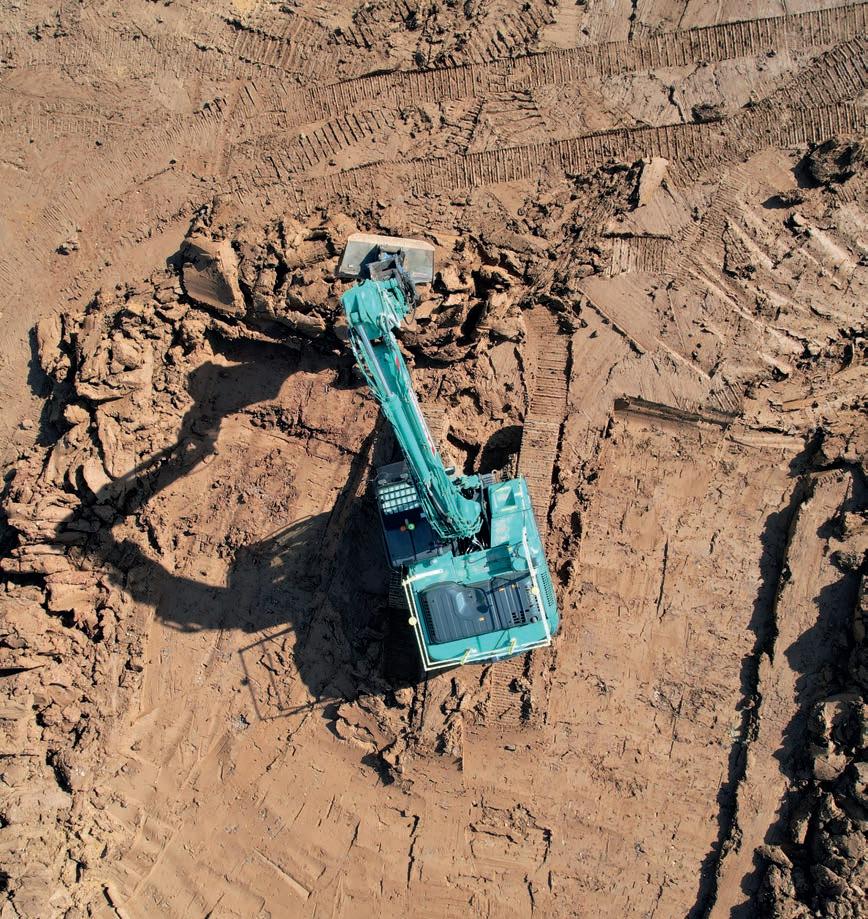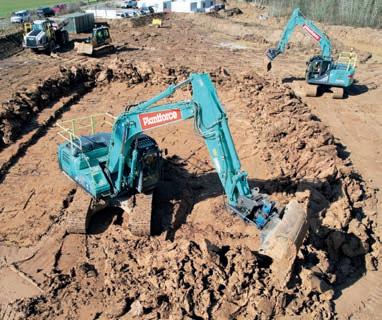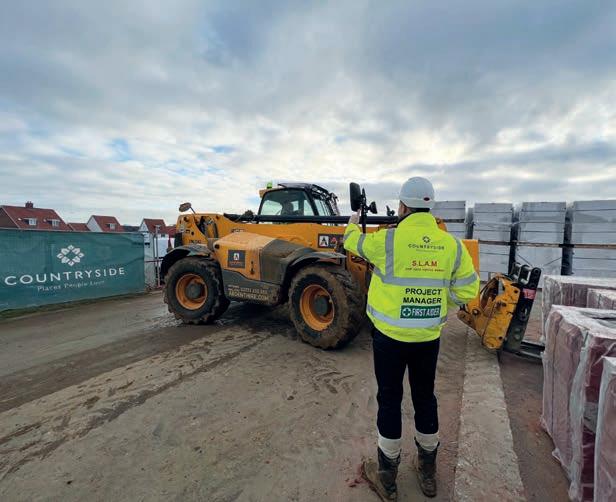
7 minute read
Digital innovation in plant
After red diesel, plant’s digital future
The construction equipment sector is raising productivity levels through tech investment. Peter Haddock talks to plant’s digital innovators
Advertisement
D
igital transformation has taken the plant sector by storm over the past year. Major clients are demanding machine control technology, while concerns about emissions have forced the industry to focus on improving productivity.
“When both National Highways and HS2 mandated the use of machine control, rental fleets began to retrofit machines,” notes Neil Williams, UK director for heavy construction at machine control specialist Leica Geosystems.
“Added to that, the acute shortage in operators, the road to net zero emissions, COP26 and fuel costs have focused minds. The change from red to white diesel in April 2022 is the latest catalyst for technology adoption.”
National Highways used the Futureworx exhibition in March to launch the next phase in its Digital Roads Strategy, through its industry-led Connected and Autonomous Plant (CAP) group. It unveiled a new industrywide scoring system which rates equipment according to its level of automation.
Annette Pass is head of innovation at National Highways. “This standardised measure, the first of its kind, will offer clarity and a clear way to compare different types of machinery to suit different tasks,” she explains.
“It’s a key part of our CAP Roadmap that we launched jointly with i3P (Infrastructure Industry Innovation Partnership) in June 2020. This supports our goal of making automation business as usual in construction by 2035.
“With our new CAP Levels Maturity Matrix, we can establish a common language and framework so connected and autonomous plant can be deployed on construction schemes. This gives suppliers and manufacturers a simple way of describing the capability of their products, with everyone using the same language.”
Pass believes CAP can improve productivity by more than £200bn by 2040 in the construction sector.
“We are committed to making it standard industry practice.
“We have already benefited from mandating intelligent machine control on our projects. We see a future where the operator may not be in the machine and could even control it from the other side of the world.”
Modelling earthworks using Agtek Gradework software Growth in digital tech is helping drive plant productivity We see a future where the operator may not be in the machine and could even control it from the other side of the world
Annette Pass, National Highways
Annette Pass of National Highways believes CAP can improve productivity by more than £200bn by 2040 in the construction sector
200

Mark Lawton, Skanska
Connecting machines via one project dashboard
At Futureworx, Plantforce Rentals showed how it is remotely monitoring site work in real time
Tier 1 contractors are supporting the plant sector’s digital transformation. Mark Lawton is head of engineering for Skanska. He describes the adoption of machine control as a “herd of elephants” running straight at the plant industry.
“The digital inputs for a modern machine are like those of a manufacturing-style robot,” he says. “The machine needs very simple inputs to perform the right tasks and, in turn, output the data to tell us what it has completed.
“The challenge, therefore, is to ensure we have the right data inputs, and that means designing 3D models for the machines, not just the project. This requires new digital skillsets across the board and investment in training. We need to attract digitally minded talent. This needs to happen at every level, from surveyors to engineers and site managers to operators.”
Lawton’s vision is a digital earthworks twin. “We could then undertake digital rehearsals with the client before a machine is specified for the job,” he says. “This would also allow experts from all parts of the world to collaborate, enabling the best possible project outcomes.”
This will partly depend on the technology infrastructure, Lawton says. “We need the ability to connect individuals and machines together through a robust GPS network,” he says. ●
Plantforce Rentals is one hirer demonstrating the potential for digital tech on heavy construction projects. At the Futureworx show in March, it set up a live ‘connected site’ demonstration, which linked all machines together on a single project dashboard. The hirer operated this from its training facility, run by LP Training near Stratford-upon-Avon, some 80 miles away from the event.
The company used a fleet including two Kobelco excavators, one with Leica Geosystems’ semi-automatic system, the other with Trimble 3D machine control, and a Trimble-enabled Cat dozer. They were linked together by telemetry specialist MachineMax’s equipment management platform.
Plantforce COO Sam Mercer says: “The MachineMax solves one of the biggest industry problems, collating information from different machine types into one dashboard. This allows us to take data and turn it into useful information, which is in turn fed to the people managing the operation.”
Plantforce connected each machine to the platform using a magnetised telemetry box that picks up the equipment manufacturer’s API. This is a data feed available from the machine, which allows real-time
Hirer Plantforce can link information from different machines on a single project dashboard This solves one of the biggest industry problems, collating information from different machine types into one dashboard

Sam Mercer, Plantforce Rentals
activity to be measured, whether in operation or idling.
“In this case, our team were monitoring activities like digging, grading and hauling, picking up on productive and idling times, fuel burn and CO2 emissions,” explains Mercer. “Idling is when the machine is being unproductive yet using fuel, so this is a key focus for us. We can alert site managers to excessive idling by setting alerts and best practice benchmarks.
By looking at data in real time, he says, a site management team can work out how much fuel is used for specific tasks. They can pick up productivity issues – such as a traffic jam of articulated dump trucks due to poor weather conditions impacting cycle times – and act immediately.
“Plus, there is the benefit of theft prevention and knowing where every asset is at any time, which was how telemetry first made a big impact in the industry,” he adds.

Using AI to drive plant safety
Countryside has introduced anti-collision technology from Safety Shield to prevent accidents on its housebuilding sites
H
ousebuilder Countryside recently mandated AI-driven anti-collision technology from tech firm Safety Shield for construction machines on its sites.
Michelle Dearsley is Countryside’s group health and safety director. “We all know that construction is a highrisk environment, so it’s important to constantly look at how we can improve safety on site, particularly for mobile plant,” she explains.
“We use a lot of telehandlers around our sites and recognised new technologies were coming into the market. We trialled various systems and ended up happily working with an AI solution from Safety Shield. We’ve introduced this across our sites, the first housebuilder in the UK to do so.”
One of Countryside’s plant hire partners, Arden, has introduced the Safety Shield technology on its JCB telehandlers.
The AI solution uses software and 360 video cameras fitted around the machine to identify the human form, differentiating it from other objects around the site. If an individual moves into the amber or red zone around the machine, or the machine is moving too close to an operative performing a task, it alerts the operator in the cab and sounds an audible alarm.
The active nature of the system also stops the machine, automatically preventing an accident from happening. The cameras, which roll constantly, also record a clip before, during and after an alert, sending information to the Countryside team in real-time. Safety Shield also provides a monitoring service to support customers.
Safety Shield CEO Jonathan Guest says: “This approach makes a huge impact on sites as operators are supported by 360-degree digital eyes around the machine. Because the videos are captured on site, they are impactful and help to change behaviours. Some of our customers have even changed the way they manage tasks to make them safer.” ●
Countryside is using AI anticollision tool Safety Shield on its sites It’s important to constantly look at how we can improve safety on site, particularly for mobile plant










